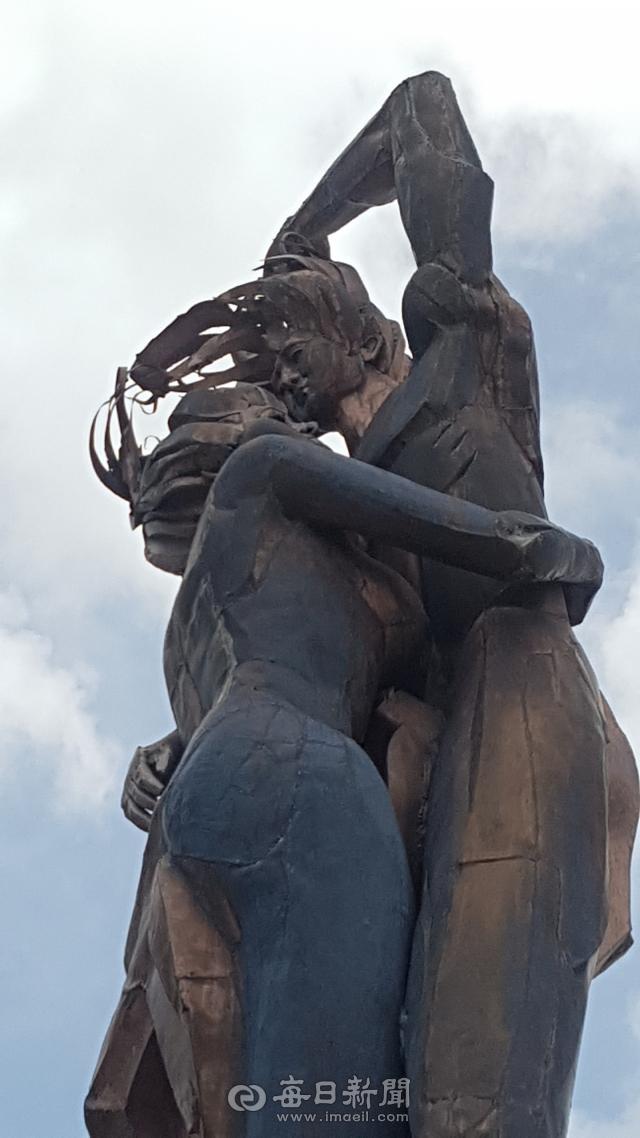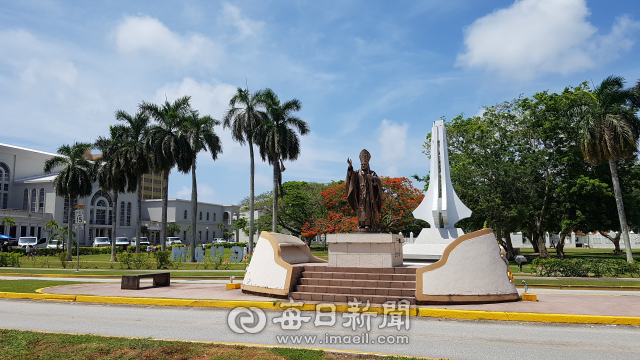
Touring Guam Molded by Time
333 Years of Spanish Rule
A history of control by 3 different countries made into a tourism resource
March 6, 1521
It was the day a new history began on the island of Guam. To explain further, it was the day the hidden jewel of Guam was first introduced to mankind. The 16th century was a time when mankind set sail towards a new and unknown continent and a period when western nations sailed around the globe discovering new lands. One of the gems the Europeans discovered during this period was Guam. The first country which discovered and claimed the island was Spain. As time passed, it came under the control of the US followed by Japan. It was finally annexed as a territory of the United States which it remains a part of until this day. That is why the cultures of Spain, the US, and Japan can all be found on Guam. Due to the influence of being under Spanish rule for most of its history, the population is predominantly catholic while the main language spoken is English being a present-day territory of the US. Although the island's rule under the Japanese was short-lived, it is one of the places in the world where it is possible to see a piece of Japan's history riddled with the scars from WWII.
◆ The History of Guam
In 1519, the Portuguese-born Spanish explorer, Ferdinand Magellan (1480~1521), set sail on an expedition to circumnavigate the world with a fleet of 5 ships including the Victoria funded by the King of Spain. Magellan's fleet arrived in Umatac Bay located on the Southern coast of Guam on March 6, 1521. They found a place to set their anchors and to make repairs. They spent 3 days on Guam and was captivated by the beauty of the island.
The cobalt waters, white sand beaches, green coconut trees, and juicy tropical fruits were enough to stimulate their senses. Especially, the natives living on Guam called Chamorros kindly welcomed the Spanish explorers. Although it was the first time the Chamorros encountered foreigners, they showed the explorers their hospitality by offering food and supplying them with needed supplies. Upon completion of repairs to their ships and having received a lavish welcome from the locals, the Spanish explorers were captured by greed to possess the beautiful island forever. Eventually, Guam came under Spanish control for a period of 333 years.
After control was transferred to the US after the Spanish-American War in 1898, the island was invaded and taken over by the Japanese during the Pacific War in 1941. The Japanese also forcefully relocated many Koreans to Guam and subjected them to all sorts of hardships. The US regained control over Guam in 1944 and declared it as an official territory in 1950 which it remains as up until today.

◆ Tourist Sites from the Colonial Past
The Plaza de España is located at the heart of the capital, Hagåtña. Originally the Palace of the Spanish Governor, it was mostly destroyed during WWII and only a part of it remains standing today. Next to the plaza is where the Dulce Nombre de Maria Cathedral-Basilica is located. It was the first church built on Guam in 1699 and its white exterior is breathtaking. A statue of John Paul II stands in front of the cathedral. It was erected in 1981 in honor of the pope's visit to Guam. The funny thing about it is that it was made to rotate 360 degrees throughout the day as symbol of spreading the pope's blessing in all directions.
Paseo Park has the meaning of "Susana's Park" in the native Chamorro language. It is a park built on a man-made peninsula. After being liberated from Japan in 1944, the remnants of the war in Hagåtña were dumped into the ocean with bulldozers and a beautiful park was built on top of the newly claimed land. There is a baseball field amongst other sports facilities in the park and it is a place where tourists and locals come to relax during the weekend. Furthermore, a replica of the Statute of Liberty stands at the tip of the peninsula. The statue was present from the Boy Scouts of America in 1950 in commemoration of its 40th anniversary.

◆ History of the Chamorros
As it might be expected, the native Chamorro people constitute the majority of Guam's population. They speak their native language as well as English. Most Chamorros are farmers growing crops such as coconuts, cacao, sugar cane, coffee, rice, corn, and tropical fruits. Moreover, they are also in charge of reenacting and reconstructing traditional culture in the tourism sector. They are sharing their culture to visitors at major tourist sites or parks around the island by reconstructing traditional dwellings or wearing traditional clothing.
The prime example of such efforts is the Chamorro Village. It is a place where visitors can experience Chamorro traditions and culture. Handcrafted items are sold in the village and tourists can try traditional dishes such as barbeque seasoned with local chili peppers and red rice.
Perhaps the most popular tourist site on Guam related to the Chamorros is Two Lovers Point. The story dates back to the Spanish colonial era. The chief's daughter fell madly in love with a Chamorro man, but the chief wished for her to get married to a Spanish officer. They loved each other so much that they chose death instead of being forcefully married to someone they did not love. They stood at the cliff overlooking Tumon Beach and jumped into the ocean below with their long hair braided together. The two disappeared into the vast ocean and the cliff came to be known as the Two Lovers Point, in essence, the Cliff of Love. It is a "must-see" site for lovers around the globe up until this very day. The bell installed at the site contributes greatly to its popularity due to the belief that if two lovers ring the bell at the same time, their love will last forever.
One of the relics left behind by ancient Chamorros are latte stones. It has been said that Chamorros built houses dating as far back as 500 B.C. They constructed houses raised on top of stone pillars to avoid the torrential downpours common to tropical climates. The term latte stone refers to the 6 to 8 stone pillars standing in two rows. The houses were built on hemispherical stones called tasa placed on top of the pillars called haligi. Although no one has solved the mystery of what type of dwelling the Chamorros built on top of the latte stones, they are still relics which prove the continuation of the Chamorro's history as well as being another tourism element of Guam.
Guam was discovered by Spanish explorers on March 6, 1519 and was subject to Spain's colonial rule for 333 years. After the Spanish, control went back and forth between the US and Japan resulting in a unique culture on the island influenced by the three countries.
Plaza de España was built on the site of the Palace of the Spanish Governor which was destroyed during the Pacific War. At the center of the plaza is a statue of Pope John Paul II which rotates to symbolize that it is extending its blessing to all corners of the world.
Paseo Park was built on top of a man-made peninsula built from the rubbles left behind by the war after the island was retaken from the Japanese. It is a popular walking path among locals due to the beautiful landscape and sculptures found there.
The native Chamorros also play a big role in the tourism sector. Through the restoration and reenactment of traditions, they present tourists with Guam's history, valuable lessons and leave a lasting impression in their hearts.
Chamorros play an important role in various areas within the tourism sector by making use of craftsmanship handed down through generations. They present tourists with interesting experiences such as making handcrafted items out of palm leaves or lighting fire using simple tools.
The island of Guam is surrounded by the ocean and has a tropical climate. Therefore, dwellings were located in places near the coast. As such, natives used boats as one of the main modes of transportation on the island due to their high mobility. The traditional canoes made out of a single tree trunk were used for fishing and transporting crop to distant places.
It is common for famous tourist spots to have its own story. Perhaps, the best tourist site related to the Chamorros is the Two Lovers Point. It is a cliff where two Chamorro lovers jumped into the ocean in order to protect their love for eternity. The cliff is now a must-see site for lovers all across the globe.
Latte stones are monumental heritage left behind by the ancient Chamorros who constructed houses since 500 B.C. Through these ancient relics, it was possible to rediscover the continuing history of the Chamorros. They serve as another tourism element of Guam which appeals to tourists.






































댓글 많은 뉴스
'갭투자 논란' 이상경 국토차관 "배우자가 집 구매…국민 눈높이 못 미쳐 죄송"
문형배 "尹이 어떻게 구속 취소가 되나…누가 봐도 의심할 수밖에 없는 사건"
"아로마 감정오일로 힐링하세요!" 영주여고 학생 대상 힐링 테라피 프로그램 운영
"이재명 성남시장 방 옆 김현지 큰 개인 방" 발언에 김지호 민주당 대변인 "허위사실 강력규탄"
'금의환향' 대구 찾는 李대통령…TK 현안 해법 '선물' 푸나